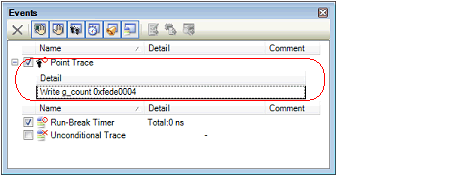Use one of the following methods to set a Point Trace event.
Also see "2.19.7 Notes for setting events" for details on Point Trace events (e.g. limits on the number of enabled events). |
[Full-spec emulator][E1][E20] |
[Simulator] |
Perform this operation in the Editor panel/Disassemble panel in which the source text/disassembled text is displayed.
Follow the operation listed below from the context menu, in accordance with your desired access type, after selecting the variable or I/O register as the subject to access.
Note, however, that only global variables, static variables inside functions, and file-internal static variables can be used.
Perform this operation in the Watch panel.
Select the watch-expression as the subject to access and perform the following operation from the context menu (see "2.12.6 Display/change watch-expressions").
Note, however, that only global variables, static variables inside functions, file-internal static variables, and I/O register can be used.
A watch-expression within the current scope can be specified. |
By performing the above operation, it is interpreted as if a Point Trace event has been set at the target variable/I/O register/watch-expression, and it is managed in the Events panel (see "2.19 Manage Events" for details).
